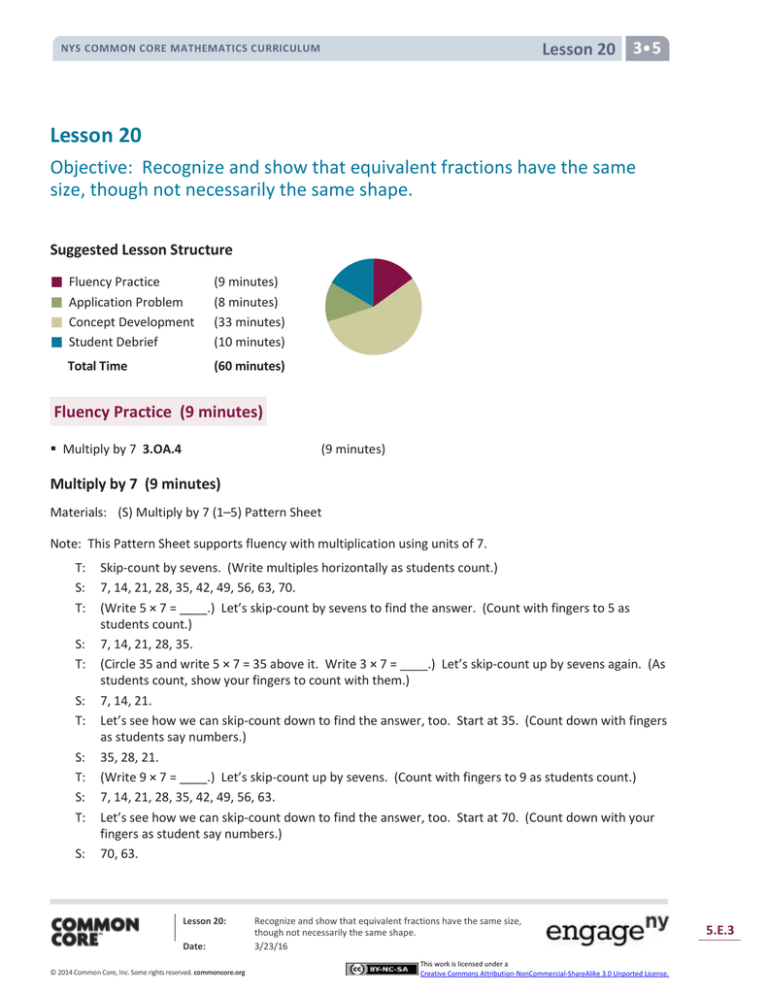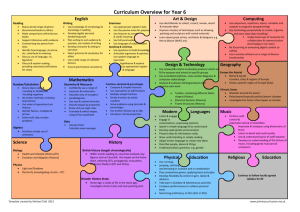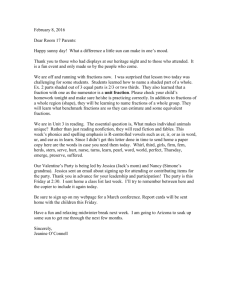
Lesson 20 3 5
NYS COMMON CORE MATHEMATICS CURRICULUM
Lesson 20
Objective: Recognize and show that equivalent fractions have the same
size, though not necessarily the same shape.
Suggested Lesson Structure
Fluency Practice
Application Problem
Concept Development
Student Debrief
Total Time
(9 minutes)
(8 minutes)
(33 minutes)
(10 minutes)
(60 minutes)
Fluency Practice (9 minutes)
Multiply by 7 3.OA.4
(9 minutes)
Multiply by 7 (9 minutes)
Materials: (S) Multiply by 7 (1–5) Pattern Sheet
Note: This Pattern Sheet supports fluency with multiplication using units of 7.
T:
S:
T:
S:
T:
S:
T:
S:
T:
S:
T:
S:
Skip-count by sevens. (Write multiples horizontally as students count.)
7, 14, 21, 28, 35, 42, 49, 56, 63, 70.
(Write 5 × 7 = ____.) Let’s skip-count by sevens to find the answer. (Count with fingers to 5 as
students count.)
7, 14, 21, 28, 35.
(Circle 35 and write 5 × 7 = 35 above it. Write 3 × 7 = ____.) Let’s skip-count up by sevens again. (As
students count, show your fingers to count with them.)
7, 14, 21.
Let’s see how we can skip-count down to find the answer, too. Start at 35. (Count down with fingers
as students say numbers.)
35, 28, 21.
(Write 9 × 7 = ____.) Let’s skip-count up by sevens. (Count with fingers to 9 as students count.)
7, 14, 21, 28, 35, 42, 49, 56, 63.
Let’s see how we can skip-count down to find the answer, too. Start at 70. (Count down with your
fingers as student say numbers.)
70, 63.
Lesson 20:
Date:
© 2014 Common Core, Inc. Some rights reserved. commoncore.org
Recognize and show that equivalent fractions have the same size,
though not necessarily the same shape.
3/23/16
This work is licensed under a
Creative Commons Attribution-NonCommercial-ShareAlike 3.0 Unported License.
5.E.3
Lesson 20 3 5
NYS COMMON CORE MATHEMATICS CURRICULUM
Continue with the following possible sequence: 6 × 7, 8 × 7, and 4 × 7.
T:
(Distribute Multiply by 7 Pattern Sheet.) Let’s practice multiplying by 7. Be sure to work left to right
across the page.
Directions for administration of Multiply-By Pattern Sheet are as follows:
1.
2.
3.
4.
Distribute the Pattern Sheet.
Allow a maximum of two minutes for students to complete as many problems as possible.
Direct students to work left to right across the page.
Encourage skip-counting strategies to solve unknown facts.
Application Problem (8 minutes)
Max ate
2
3
of his pizza for lunch. He wanted to eat a small snack in the afternoon, so he cut the leftover pizza
in half and ate 1 slice. How much of the pizza was left? Draw a picture to help you think about the pizza.
NOTES ON
MULTIPLE MEANS
OF REPRESENTATION:
Note: This problem reviews partitioning a whole into equal
parts from Topic A. Invite students to share their models and
1
discuss why is not a reasonable answer, even though Max cut
2
the leftover pizza in half.
Concept Development (33 minutes)
Empower English language learners to
solve the Application Problem by
connecting its context to their prior
knowledge. Discuss their experiences
at lunch, eating pizza, having leftovers,
and eating a snack.
Model 1
Materials: (T) Linking cubes in 2 colors (S) Thirds (Template),
red crayon, scissors, glue stick, and blank paper
Use linking cubes to create Model 1 as shown at the right.
T:
The whole is all of the cubes. Whisper the fraction of
cubes that are blue to your partner.
S:
(Whisper .)
Model 2
1
4
Use linking cubes to create Model 2 as shown at the right.
Lesson 20:
Date:
© 2014 Common Core, Inc. Some rights reserved. commoncore.org
Recognize and show that equivalent fractions have the same size,
though not necessarily the same shape.
3/23/16
This work is licensed under a
Creative Commons Attribution-NonCommercial-ShareAlike 3.0 Unported License.
5.E.4
Lesson 20 3 5
NYS COMMON CORE MATHEMATICS CURRICULUM
T:
Again, the whole is all of the cubes. Whisper the fraction of cubes that are blue to your partner.
S:
(Whisper .)
T:
Discuss with your partner whether the fraction of cubes that are blue in these models is equal, even
though the models are not the same shape.
They don’t look the same, so they are different.
I disagree. They are equal because they are both
1
NOTES ON
blue. They are equal because the units are still the
4
VOCABULARY:
same size, and the wholes have the same number of
units. They are in a different shape.
The concept of equivalent fractions
was first introduced in Lesson 16 in
I hear you noticing that the units make a different
reference to fractions that are at the
shape in the second model. It’s square rather than
same point on the number line. In this
rectangular. Good observation. Take another minute
lesson, the students’ understanding of
to notice what is similar about our models.
equivalent fractions expands to include
They both use the same linking cubes as units.
pictorial models, where the equivalent
fractions name the same size. Guide
They both have the same amount of blues and reds.
students to recognize the differences
Both wholes have the same number of units, and
and similarities between these
the units are the same size.
methods for finding equivalent
The size of the units and the size of the whole didn’t
fractions.
1
1
change. That means 4 and 4 are equal, or what we call
equivalent fractions, even though the shapes of our
wholes are different.
S:
T:
S:
T:
1
4
If necessary, do other examples to demonstrate the point made with Model 2.
Use linking cubes to create Model 3 as shown at the right.
T:
Why isn’t the fraction represented by the blue cubes equal to the other
fractions we made with cubes?
S:
This fraction shows 4 of the cubes are blue.
T:
When we are finding equivalent fractions, the shapes of the wholes can be
different. However, equivalent fractions must describe parts of the whole
that are the same size.
Model 3
2
Equivalent Shapes Collage Activity
Thirds Template
Students use the thirds template and follow the directions below to create
various representations of 2 thirds.
Directions for this activity are as follows:
1.
2.
3.
4.
Color the white 1 third red.
Cut out the rectangle. Cut it into 2–4 smaller shapes.
Reassemble all of the pieces into a new shape with no overlaps.
Glue the new shape onto a blank paper.
Lesson 20:
Date:
© 2014 Common Core, Inc. Some rights reserved. commoncore.org
Recognize and show that equivalent fractions have the same size,
though not necessarily the same shape.
3/23/16
This work is licensed under a
Creative Commons Attribution-NonCommercial-ShareAlike 3.0 Unported License.
5.E.5
Lesson 20 3 5
NYS COMMON CORE MATHEMATICS CURRICULUM
Invite students to look at their classmates’ work and discuss
the equivalence represented by these shapes. Each of the 6
shapes pictured to the right is an example of possible student
2
work. These shapes are equivalent because they all show 3
grey, although clearly in different shapes.
Sample Student Work
Problem Set (10 minutes)
Students should do their personal best to complete the
Problem Set within the allotted 10 minutes. For some classes,
it may be appropriate to modify the assignment by specifying
which problems they work on first. Some problems do not
specify a method for solving. Students should solve these
problems using the RDW approach used for Application
Problems.
Student Debrief (10 minutes)
NOTES ON
MULTIPLE MEANS
OF ACTION AND
EXPRESSION:
Lesson Objective: Recognize and show that equivalent fractions
have the same size, though not necessarily the same shape.
The Student Debrief is intended to invite reflection and active
processing of the total lesson experience.
Invite students to review their solutions for the Problem Set.
They should check work by comparing answers with a partner
before going over answers as a class. Look for misconceptions
or misunderstandings that can be addressed in the Debrief.
Guide students in a conversation to debrief the Problem Set and
process the lesson.
Any combination of the questions below may be used to lead
the discussion.
For students working below grade
level, break the task of labeling
fractions on the Problem Set into steps
with sentence frames:
There are ____ equal parts.
____ parts are shaded.
The fraction shaded is _____.
The open-ended questions on the
Problem Set are just right for students
working above grade level who enjoy
independence. Communicate high
expectations for explaining their
reasoning clearly with evidence.
Invite students to share their models for Problems 2(a)
and 2(b). Although answers will vary, students should
consistently represent equivalent fractions for each
question. Revisit the different work from the
Equivalent Shapes Collage Activity.
Problem 3(c) presents seeing triangles as halves of squares. Some students might put as the
8
answer since they see 8 units. You may want to pose the question, “Are all 8 parts equal units?”
4
2
Discuss how the answer can be 12 if students choose to use the base unit of triangles or 6 if they
choose to use the base unit of squares. Guide them to see that the two fractions are equivalent.
MP.6
4
Lesson 20:
Date:
© 2014 Common Core, Inc. Some rights reserved. commoncore.org
Recognize and show that equivalent fractions have the same size,
though not necessarily the same shape.
3/23/16
This work is licensed under a
Creative Commons Attribution-NonCommercial-ShareAlike 3.0 Unported License.
5.E.6
Lesson 20 3 5
NYS COMMON CORE MATHEMATICS CURRICULUM
Problem 4 also presents an interesting discussion
topic because of the use of containers that are
different shapes with the same capacity. Without
reading carefully, students are likely to make a
mistake in their answer. This may provide you
with an opportunity to further explore the
difference between different-sized wholes and
different-looking wholes.
Earlier, you learned that equivalent fractions are
at the same point on the number line. How did
your understanding of equivalent fractions
change today?
Exit Ticket (3 minutes)
After the Student Debrief, instruct students to complete
the Exit Ticket. A review of their work will help with
assessing students’ understanding of the concepts that
were presented in today’s lesson and planning more
effectively for future lessons. The questions may be
read aloud to the students.
Lesson 20:
Date:
© 2014 Common Core, Inc. Some rights reserved. commoncore.org
Recognize and show that equivalent fractions have the same size,
though not necessarily the same shape.
3/23/16
This work is licensed under a
Creative Commons Attribution-NonCommercial-ShareAlike 3.0 Unported License.
5.E.7
NYS COMMON CORE MATHEMATICS CURRICULUM
Lesson 20 Pattern Sheet 3 5
Multiply.
multiply by 7 (1–5)
Lesson 20:
Date:
© 2014 Common Core, Inc. Some rights reserved. commoncore.org
Recognize and show that equivalent fractions have the same size,
though not necessarily the same shape.
3/23/16
This work is licensed under a
Creative Commons Attribution-NonCommercial-ShareAlike 3.0 Unported License.
5.E.8
NYS COMMON CORE MATHEMATICS CURRICULUM
Name
Lesson 20 Problem Set
Date
1. Label what fraction of each shape is shaded. Then, circle the fractions that are equal.
a.
b.
c.
2. Label the shaded fraction. Draw 2 different representations of the same fractional amount.
a.
b.
Lesson 20:
Date:
© 2014 Common Core, Inc. Some rights reserved. commoncore.org
Recognize and show that equivalent fractions have the same size,
though not necessarily the same shape.
3/23/16
This work is licensed under a
Creative Commons Attribution-NonCommercial-ShareAlike 3.0 Unported License.
5.E.9
Lesson 20 Problem Set
NYS COMMON CORE MATHEMATICS CURRICULUM
3. Ann has 6 small square pieces of paper. 2 squares are grey. Ann cuts the 2 grey squares in half with a
diagonal line from one corner to the other.
a. What shapes does she have now?
b. How many of each shape does she have?
c. Use all the shapes with no overlaps. Draw at least 2 different ways Ann’s set of shapes might look.
What fraction of the figure is grey?
1
4. Laura has 2 different beakers that hold exactly 1 liter. She pours 2 liter of blue liquid into Beaker A. She
1
pours 2 liter of orange liquid into Beaker B. Susan says the amounts are not equal. Cristina says they are.
Explain who you think is correct and why.
A
Lesson 20:
Date:
© 2014 Common Core, Inc. Some rights reserved. commoncore.org
B
Recognize and show that equivalent fractions have the same size,
though not necessarily the same shape.
3/23/16
This work is licensed under a
Creative Commons Attribution-NonCommercial-ShareAlike 3.0 Unported License.
5.E.10
NYS COMMON CORE MATHEMATICS CURRICULUM
Name
Lesson 20 Exit Ticket
Date
1. Label what fraction of the figure is shaded. Then, circle the fractions that are equal.
2. Label the shaded fraction. Draw 2 different representations of the same fractional amount.
a.
b.
Lesson 20:
Date:
© 2014 Common Core, Inc. Some rights reserved. commoncore.org
Recognize and show that equivalent fractions have the same size,
though not necessarily the same shape.
3/23/16
This work is licensed under a
Creative Commons Attribution-NonCommercial-ShareAlike 3.0 Unported License.
5.E.11
Lesson 20 Homework 3 5
NYS COMMON CORE MATHEMATICS CURRICULUM
Name
Date
1. Label the shaded fraction. Draw 2 different representations of the same fractional amount.
4
2. These two shapes both show 5.
a. Are the shapes equivalent? Why or why not?
4
b. Draw two different representations of 5 that are equivalent.
3. Diana ran a quarter mile straight down the street. Becky ran a quarter mile on a track. Who ran more?
Explain your thinking.
Diana
Becky
Lesson 20:
Date:
© 2014 Common Core, Inc. Some rights reserved. commoncore.org
Recognize and show that equivalent fractions have the same size,
though not necessarily the same shape.
3/23/16
This work is licensed under a
Creative Commons Attribution-NonCommercial-ShareAlike 3.0 Unported License.
5.E.12
NYS COMMON CORE MATHEMATICS CURRICULUM
Lesson 20 Template
thirds
Lesson 20:
Date:
© 2014 Common Core, Inc. Some rights reserved. commoncore.org
Recognize and show that equivalent fractions have the same size,
though not necessarily the same shape.
3/23/16
This work is licensed under a
Creative Commons Attribution-NonCommercial-ShareAlike 3.0 Unported License.
5.E.13







